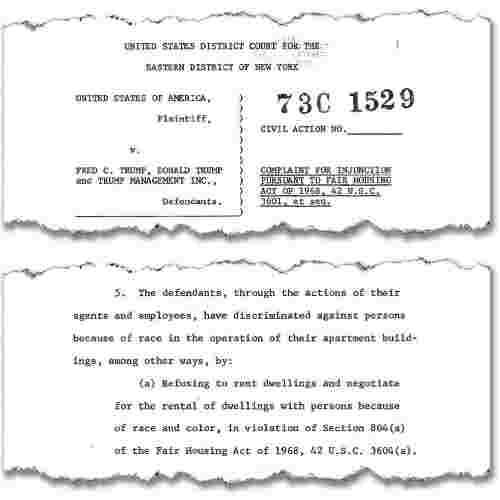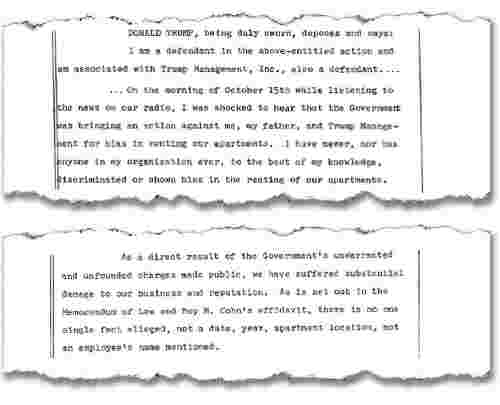Inside the Government's Racial Bias Case Against Donald Trump's Company, and How He Fought It
NEW YORK — When a black woman asked to rent an apartment in a Brooklyn complex managed by Donald Trump’s real estate company, she said she was told that nothing was available. A short time later, a white woman who made the same request was invited to choose between two available apartments.
The two would-be renters on that July 1972 day were actually undercover “testers” for a government-sanctioned investigation to determine whether Trump Management Inc. discriminated against minorities seeking housing at properties across Brooklyn and Queens.
Federal investigators also gathered evidence. Trump employees had secretly marked the applications of minorities with codes, such as “No. 9” and “C” for “colored,” according to government interview accounts filed in federal court. The employees allegedly directed blacks and Puerto Ricans away from buildings with mostly white tenants, and steered them toward properties that had many minorities, the government filings alleged.
In October 1973, the Justice Department filed a civil rights case that accused the Trump firm, whose complexes contained 14,000 apartments, of violating the Fair Housing Act of 1968.
The case, one of the biggest federal housing discrimination suits to be brought during that time, put a spotlight on the family empire led by its 27-year-old president, Donald Trump, and his father, Fred Trump, the chairman, who had begun building houses and apartments in the 1930s. The younger Trump demonstrated the brash, combative style that would make him famous, holding forth at a news conference in a Manhattan hotel to decry the government’s arguments as “such outrageous lies.” He would also say that the company wanted to avoid renting apartments to welfare recipients of any color but never discriminated based on race.
The Trumps retained Roy Cohn, a defense attorney who two decades earlier had been a top aide to Sen. Joseph McCarthy (R-Wis.) during his infamous effort to root out communists in government. Cohn portrayed the Trumps as the victims and counter-sued the government, demanding it pay them $100 million for falsely accusing them of discrimination.
(Tear sheet from U.S. v Fred Trump complaint from October 1973. )
For Trump, whose statements as a presidential candidate about Mexican immigrants, women and Muslims have drawn charges of racism and sexism, his role as a defendant in a discrimination case put him near the center of a civil rights-era struggle over society’s changing views about race and culture. The 20-month legal battle marked the first time Trump became a regular presence on newspaper front pages. It served as an early look at the hardball tactics he has employed in business and, more recently, in politics. And its resolution showed how Trump, even in the heat of battle, is often willing to strike a deal.
This account is based on a review of more than 1,000 pages of court records, including hearing transcripts and affidavits that have received little attention in the decades since the case, as well as interviews with people involved in the case.
Aspects of the case were reported at the time, and other details, such as the racial coding allegations, gained notice in a 1979 Village Voice investigation and more recently in a Daily Beast story.
Trump declined to be interviewed. His attorney, Alan Garten, said via email that there was “absolutely no merit to the allegations.”
“This suit was brought as part of a nationwide inquiry against a number of companies, and the matter was ultimately settled without any finding of liability and without any admission of wrongdoing whatsoever,” Garten said.
Donald Trump’s ascent in his family’s business, after his 1968 graduation from business school, came as allegations of race discrimination were mounting against landlords across New York City. Housing bias had become a major policy issue in Congress.
Many whites were relocating to the suburbs, and minorities often moved in to rent or buy properties. Concern about the issue peaked following race riots that broke out across the country after the assassination of the Rev. Martin Luther King Jr.
Amid growing evidence that landlords were refusing to rent to minorities, Congress acted one week after the King assassination by passing the Fair Housing Act of 1968, which banned such discrimination.
The Trumps’ company had encountered allegations of discrimination before Donald Trump arrived. On at least seven occasions, people seeking apartments had filed complaints about alleged “discriminatory practices” with the New York City Commission on Human Rights.
The company resolved the complaints individually by offering apartments to each minority applicant, but critics in New York said the patterns of bias continued.
As company president, Donald Trump took an interest in all levels of the business, according to his own accounts. He often helped his father with management chores, including collecting rent, sometimes from unruly tenants.
Civil rights groups in the city viewed the Trump company as just one example of a nationwide problem of housing discrimination. But targeting the Trumps provided a chance to have an impact, said Eleanor Holmes Norton, who was then chairwoman of the city’s human rights commission. “They were big names,” said Norton (D), now the District’s representative in Congress.
Organizations such as the Urban League began to send testers to Trump properties.
In the July 1972 test at Shorehaven Apartments in Brooklyn, the same superintendent who had rejected the black woman told the white woman who came later that she could “immediately rent either one of two available apartments,” according to testimony.
The tests played out across Queens and Brooklyn and revealed a pattern, the housing activists said in court filings. White testers were encouraged to rent at certain Trump buildings, while the black testers were discouraged, denied or steered to apartment complexes that had more racial minorities, according to the testimony.
After local activists realized the scope of their findings, they alerted the Justice Department’s civil rights division, which was looking for housing cases to pursue.
Two former Trump employees, a husband and wife who rented properties, were quoted in court documents as saying they were told that the company wanted to rent only to “Jews and Executives” and “discouraged rental to blacks.” The couple told the government’s lawyers that they were advised that “a racial code was in effect, blacks being referred to as ‘No. 9.’ ”
Other rental agents employed by the Trumps told the FBI that only 1 percent of tenants at the Trump-run Ocean Terrace Apartments were black, and that there were no black tenants at Lincoln Shore Apartments. Both were on Ocean Parkway in Brooklyn. However, minorities were steered to a different complex on Flatbush Avenue in Brooklyn, Patio Gardens, which was 40 percent black, the government said.
One black woman, for example, was turned away at a heavily white complex but told that she should “try to obtain an apartment at Patio Gardens,” where “a black judge had recently become a tenant,” according to government filings.
Phyllis Spiro, a white woman who went undercover in 1973 at a Trump property, told investigators how a building superintendent acknowledged to her “that he followed a racially discriminatory rental policy at the direction of his superiors, and that there were only very few ‘colored’ tenants” at the complex, according to court records.
Spiro, now 86 and living in Brooklyn, said in an interview that she remembers the case vividly. She said she and her fellow housing activists found “a constant pattern and practice of discrimination” at Trump buildings.
Working from offices in Washington and New York, Justice Department lawyers decided to file a case: United States of America v. Fred C. Trump, Donald Trump and Trump Management, Inc.
On the morning of Oct. 15, 1973, a Justice Department official reached Donald Trump on the telephone. It was a courtesy call, the official would later say in court papers. The Justice Department then issued a news release that said the Trumps violated the law “by refusing to rent and negotiate rentals with blacks, requiring different rental terms and conditions because of race, and misrepresenting that apartments were not available.”
At the time the suit was filed, Trump had been thinking about veering away from his father’s focus on providing housing for lower- and middle-income residents of Brooklyn and Queens, and envisioning his future as a developer of luxury buildings for the rich in Manhattan.
But now the first thing most people were hearing about Trump was that he was being accused of discrimination.

In another housing case shortly before then, a New York developer had quickly settled with the government. But Trump wanted to fight.
“The idea of settling drove me crazy,” he wrote in “The Art of the Deal.”
“What we didn’t do was rent to welfare cases, white or black,” Trump wrote in his 1987 autobiography. “I’d rather fight than fold, because as soon as you fold once, you get the reputation of being a folder.”
Trump struck up a conversation with Cohn, the famous lawyer, whom he had met because both men were members of Le Club, an exclusive discotheque.
“I knew him by reputation and was aware of his image as a guy who wasn’t afraid to fight,” Trump wrote in his book.
Cohn, who died in 1986, advised Trump to tell the government to “go to hell,” according to Trump’s book. Cohn counseled pursuit of a strategy that remains key to Trump’s playbook today: When attacked, hit back harder. On Dec. 12, 1973, Trump held a news conference at the New York Hilton to announce a counterclaim, saying the government knowingly made false and misleading statements. Cohn sought $100 million for the Trumps. Donald Trump claimed that the government was trying to force the company to lease apartments to people on welfare.
If that happened, Trump said, “there would be a massive fleeing from the city of not only our tenants, but communities as a whole,” according to news accounts from the time.

(Tear sheet from Trump affidavit from December 1973.)
Trump, in an affidavit, rejected any suggestion that his view was based on race. “I have never, nor has anyone in our organization ever, to the best of my knowledge, discriminated or shown bias in renting our apartments,” he said.
Cohn filed his own affidavit lamenting what he suggested was an overzealous government.
“No matter what the outcome of this case,” Cohn said, “I suppose the damage is never going to be completely undone because you are never going to catch up with these initial headlines.”
Five weeks later, Cohn and the Trumps sat in a federal district courtroom in Brooklyn. Seated at the government’s table was a 26-year-old Justice Department lawyer, Elyse Goldweber, drenched from a downpour because she had been unable to find a cab.
At issue was whether the judge should let the Trumps’ countersuit continue, or, as the government wanted, for the judge to toss it out.
Goldweber had a passion for her task. One of her clearest childhood memories was regularly taking a ferry in southern Virginia to visit her grandparents. Two signs greeted her as she came on board: “White” and “Colored.” Her first big case was against the Trumps.
Cohn spoke first, ridiculing the government for requesting racial breakdowns of Trump buildings.
There are “a number of blacks who live in there, that we know visibly,” Cohn said, according to a court transcript.
“I have taken a ride and looked at some of them and blacks walk in and out and I assume they are not there for any improper purpose and they live in the place,” Cohn said. “But they want us to go, apparently, and canvass all 14,000 of these units and find out how many blacks live there and how many non-blacks live there, and I suppose how many Puerto Ricans live there or non-Puerto Ricans.”
Goldweber recalled in an interview that she was “a nervous wreck” as she faced off against Cohn and the Trumps.
In court, Goldweber urged the judge to dismiss the counterclaim and let the government’s discrimination case go forward. Judge Edward R. Neaher agreed.
The Trumps and their attorney then turned their attention to undermining key aspects of the government’s case.
The legal team went after the claims that Trump employees used coded language to refer to minorities. This case had originated in part from one employee, who told the government that he was instructed to mark rental applications from blacks with the letter “C” for “colored,” and that “he did this every time a black person applied for an apartment,” according to an affidavit from Goldweber. The employee said he didn’t want to be identified in the case because “he was afraid that the Trumps would have him ‘knocked off,’ or words to that effect, because he told me about their allegedly discriminatory practices,” according to the affidavit.
Court transcripts show how the Trump lawyers then attempted a new tactic: attacking the credibility of the government’s lawyer. They drafted an affidavit for the employee, in which he denied making such statements. In the signed statement, the employee claimed that the Justice Department lawyer who replaced Goldweber, Donna Goldstein, told him to “lie” or risk being “thrown in jail.” The employee described himself as a “Spanish-speaking Puerto Rican hired directly by Mr. Donald Trump.”
Goldstein and other Justice officials vehemently denied that she made any threats. Goldstein, now a California Superior Court judge, declined to comment on the case.
Cohn said in an affidavit that Goldstein was conducting a “gestapo-like interrogation.” A Cohn colleague wrote to the Justice Department that its agents were “descending upon the Trump offices with five stormtroopers.”
Cohn wanted the judge to hold Goldstein in contempt. But Cohn’s effort went nowhere. The judge admonished Cohn for his language and said in a hearing that his accusations against the Justice Department were “utterly without foundation.”
Despite Trump’s claims that he hated to settle, he and his father authorized Cohn to make a deal.
Nearly two years of fighting was about to come to an end. But a hitch delayed the signing of a consent decree.
The Justice Department wanted the Trumps to place advertising in local newspapers that assured prospective renters that they were open to people of all races.
The hitch was the cost. Donald Trump went into negotiating mode.
“This advertising, while it’s, you know — I imagine it’s necessary from the Government’s standpoint, is a very expensive thing for us,” Trump said, according to a court transcript. “It is really onerous. Each sentence we put in is going to cost us a lot of money over the period we are supposed to do it.”
When government officials persisted, Trump said, “Will you pay for it?”
The two sides eventually came to terms. On June 10, 1975, they signed an agreement prohibiting the Trumps from “discriminating against any person in the terms, conditions, or priveleges of sale or rental of a dwelling.” The Trumps were ordered to “thoroughly acquaint themselves personally on a detailed basis” with the Fair Housing Act.
The agreement also required the Trumps to place ads informing minorities they had an equal opportunity to seek housing at their properties.
The decree makes clear the Trumps did not view the agreement as a surrender, saying the settlement was “in no way an admission” of a violation.
The Justice Department claimed victory, calling the decree “one of the most far-reaching ever negotiated.”
Newspaper headlines echoed that view. “Minorities win housing suit,” said the New York Amsterdam News, which told readers that “qualified Blacks and Puerto Ricans now have the opportunity to rent apartments owned by Trump Management.”
Goldweber, the Justice lawyer who originally argued the case, said it was a clear government victory.
The government “had the coding, they had the testers , and had the testimony of people who worked there,” said Goldweber, now a private practice lawyer in New York. “It was an important, significant step for enforcement of the Fair Housing Act. It was a big deal.”
That’s not how Donald Trump considered it. He declared victory, in part because the agreement specifically stated that Trump made the deal without acknowledging wrongdoing.
In his autobiography Trump minimized the case’s impact. “In the end the government couldn’t prove its case, and we ended up making a minor settlement without admitting any guilt.”
Alice Crites in Washington contributed to this report.
Michael Kranish is a national political investigative reporter for The Washington Post. He is the co-author of biographies of Mitt Romney and John Kerry, author of "Flight from Monticello: Thomas Jefferson at War," and former Washington Bureau deputy chief of The Boston Globe.
Robert O'Harrow Jr. is a reporter on the investigative unit of The Washington Post. He writes about law enforcement, national security, federal contracting and the financial world.


Spread the word